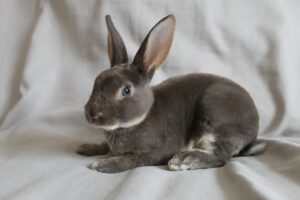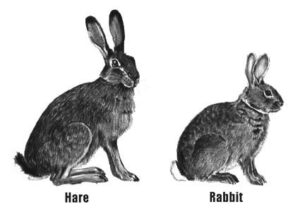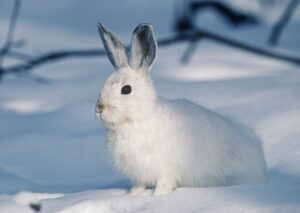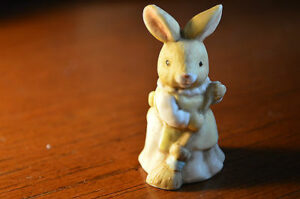The Dewlap is a bit of fluffed up skin and fur below a rabbit’s neck or jaw.Both male and female rabbits have a dewlap but it is more prominently found in female rabbits who have reached adulthood. Female rabbits can use the fur on their dewlap to create a nest for her offspring when she is about to give birth.
1. What Is A Dewlap?
A Dewlap refers to a flap of skin and fur just below a rabbits jaw. You may have seen on many rabbits before. It looks like a double chin, especially when they are resting.
It contains soft fur that is loosely attached to the skin underneath. The skin of a dewlap is also lined with fatty tissue giving it a bulgy appearance which hangs from their neck.
Dewlaps are completely natural to pet rabbits even though they may differ in size and shape. Some rabbits have large or pronounced dewlap while others may have a very small dewlap.
There are a lot of factors that determine the size of the dewlap like breed, age, gender, diet and exercise. Plus other animals like dogs and moose also can have a dewlap.
2. Why Do Rabbits Need A Dewlap?
The purpose of the dewlap is quite complex even if it is not apparent at first glance. It serves many roles in rabbits, from providing shelter for their offspring to storing fat to survive the winter season.
When female rabbits (called does) reach sexual maturity their body goes through many changes, the most noticeable is the enlargement of their dewlap.
Rabbits often give birth on the ground or in burrows underground. After being born, rabbit babies are really small, fragile and blind. That makes them quite vulnerable, that is why the mother rabbit tries to provide a soft surface for her babies to rest and suckle on.
Pregnant rabbits pick the fur off from their dewlap and line it on the ground she is going to give birth in to make a nest. After the babies (which are called kits) are born they cling on to their mother teats on her bare chest and belly.
Having a bare chest without fur helps to keep the small babies warm while they drink milk and sleep. Cold weather can quickly kill the kits who are born without any fur on their body.
3. Do All Female Rabbits Have Dewlaps?
Almost all female and some male rabbits have a dewlap but they vary greatly in size. Some breeds can have a large pronounced dewlap while others do not. The size of the dewlap in rabbit can also vary greatly between individuals. That being said, some breeds do have larger dewlaps than others.
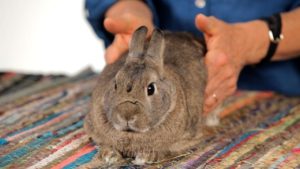
The American Rabbit Breeder Association or ARBA calcifies rabbit breeds by the size of their dewlaps.
i. Which Breeds Have A Pronounced Dewlap?
Some rabbit breeds have significantly larger dewlaps when compared to others. These rabbit breeds tend to be on the larger side although lop rabbits are an exception. Breeds that are well known to have a dewlap are
- Flemish Giant Rabbit
- Belgian Hare Rabbit
- Californian Rabbit
- French Lop Rabbit
Some other breeds that can also have a pronounced dewlap but not as common as the breed mentioned before
- German lop Rabbits
- Giant Chinchilla Rabbits
- Mini Lop Rabbits
- New Zealand Rabbits
ii. Which Breeds Have The Least Pronounced Dewlap?
According to ARBA, rabbit breeds that are classified to have smaller and less pronounced dewlaps are
- Giant Papillon Rabbit
- Self Rex Rabbits
- Havana Rabbits
- English Rabbits
- Champagne d’Argent Rabbits
Breeders and rabbit shows are very particular about which rabbits should and should not have a large dewlap. Some rabbit breeds can even be barred from participating in rabbit shows if they have a dewlap. These breeds are
- Himalayan Rabbit
- Netherlands Dwarf Rabbit
- Polish Rabbit
- Britannia Petite Rabbit
- Tan Rabbit
- Dwarf Hotot Rabbit
iii. Why Does My Rabbit Not Have A Dewlap?
Not all rabbits will have a dewlap or a particularly large one. Your rabbit may belong to one of the breed mentioned above that do not have significant dewlaps or perhaps the bunny has a very small dewlap which can be hard to distinguish.
The dewlap develops in rabbits once they reach sexual maturity, so if your rabbit is less than a year old then there is a good chance that the bunny has not hit adulthood.
Rabbits which were spayed or nutered at a very young age often lack the sexual hormones that help develop the dewlap. As fixed rabbits cannot have babies they do not need a dewlap either.
4. Why Do Some Male Rabbits Have A Dewlap?
Some male rabbits can have dewlaps. All rabbits are capable of developing a dewlap, it is just dewlaps are more common on female rabbits.
Some scientists believe that a high level of Estrogen hormone causes males to develop a dewlap. That is why dewlap are more pronounced in rabbits which were neutered at a young age before they hit sexual maturity.
Some studies also suggest overweight male rabbits tend to have larger dewlaps than those with normal weight. Male rabbits losing weight with the help of a healthy diet and regular exercise can significantly reduce the size of their dewlap over time.
If you ever feel that a male rabbit has an enlarged dewlap check for any hard bumps. A hard bump could suggest some other underlying disease. Consult your vet immediately.
5. Are There Any Health Problems Related To Dewlaps In Rabbits?
Even though dewlaps are perfectly natural for pet rabbits to have, there are a few health concerns related to them. Here are some of the most common ones.
i. Obesity
Just like humans, obesity can affect the health of pet rabbits in a negative way. Obesity is often linked to stomach problems, heart problems and even skin problems in rabbits.
Obese rabbits can have a hard time if they are females and from a breed that has a large dewlap. Overweight male rabbits can also struggle with a dewlap.
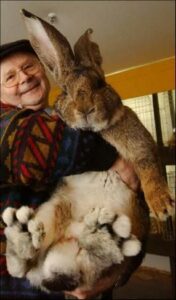
That being said, obesity in rabbits is reversible. With a healthy diet and lots of enrichment and play, pet rabbits can get back in shape.
Fitter rabbits are happier rabbits. Obese rabbits can be less active and lack enrichment in their life.
ii. Enlarged Dewlap
Some rabbits can have a Enlarged Dewlap that can become too big for them to handle. This can quickly become quite dangerous for a pet rabbit.
An enlarged dewlap can prevent a rabbit from eating and drinking properly. In that case the rabbit can deficiencies or dehydration.
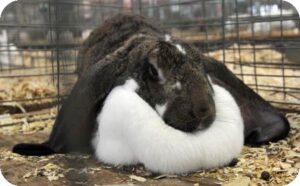
It can also affect the range of movement in a rabbit’s neck, which can give them a sore back and neck.
If you think your rabbit is having trouble with their dewlap the consult with a rabbit friendly vet. Remember rabbits are prey animal, they tend to hide any health problems so its our job that we are observant and quickly notice any illness.
iii. Pseudo Pregnancy
Rabbits build their nests by pulling out loose fur from their dewlap. But even rabbits that are not pregnant can exhibit this behavior.
This is called a Pseudo Pregnancy or False Pregnancy. That means a sexually mature female rabbit (doe) believes it is pregnant and builds its nest. Phantom pregnancy can occur in all female rabbits even if they are not housed with a male or spayed.
There are several reasons that can cause a pseudo pregnancy in a rabbits, a few of them are
- Sexual Stimulation
- Being In Close Proximity To Male Rabbits
- Infertile Mating
- Mating Behavior With Another Female
That being said, pseudo pregnancies in rabbits can occur without any apparent reason as well. Pseudo prenancies are generally not harmful for rabbits and is resolved in 10-15 days.
If your rabbit has pulled of the fur from its dewlap to make a nest then do not remove the nest from their enclosure for 15 days or so. If you remove their nest too early then it could prompt them to make another nest.
The fur on your rabbit’s dewlap should grow back in 45 days but if it does not grow back evenly or not at all the contact you vet.
iv. Improper Grooming
If a rabbit has a large dewlap due to obesity or other reasons, they may find it hard to keep up with their grooming.
Rabbits are impeccable groomers, they dedicate several hours a day to just grooming themselves. Grooming helps to remove anything dirty that may be stuck to their fur. That is why rabbits do not need to be bathe.
But if a rabbit has trouble moving its head due to an enlarged dewlap then it may struggle to groom every part of their body. If not taken care of immediately, this could cause a buildup of dirt and bacteria in their fur and skin.
Improper grooming can lead to bald patches, abscesses and even fly strike which can be very dangerous for pet rabbits.
v. Wet Dewlap
If a rabbit has a large dewlap it is susceptible to develop a wet dewlap or moist dermatitis. It is a condition that arises if the rabbit’s dewlap gets wet often and is not allowed to dry off properly.
A wet dewlap can cause a lot of serious trouble for a pet rabbit. Here are the symptoms that a rabbit may have a wet dewlap or moist dermatitis.
- Fur falling out of the dewlap skin
- The skin on the dewlap is inflamed
- the skin on the dewlap is discolored
- There are visible sores or abscesses on the dewlap
Some of the leading causes of a wet dewlap in rabbits are
- Drinking water from a bowl getting their dewlap wet every time they drink
- A leaky water bottle dropping water on their dewlap
- Housing the rabbit in wet and unsanitary conditions
- Excessive drooling from having dental problems
- Being overweight and unable to properly groom their dewlap
There could be some other underlying conditions for having a wet dewlap but these are the most common.
If you suspect that your rabbit has a wet dewlap or develop one then take action immediately. If treated early enough the problem of a wet dewlap can be solved with at home remedies.
But if the problem is significant enough to cause an infection then you should definitely consult a rabbit friendly vet.
6. How To Get Rid Of A Rabbit Dewlap?
Sometimes a rabbit’s dewlap may get really large, large enough to the point where it may impact its day to day life in a negative way. A excessively large dewlap can
- Make it hard to eat or drink
- Cause difficulty while grooming
- Give rise to matted fur
- Cause the rabbit to overheat
- Make it hard to run
That is why we need to make sure that our rabbit is comfortable with its dewlap. If you see that your bunny is struggling with a large dewlap then a few steps you can take to reduce the size of the rabbits dewlap.
By taking these steps you can effectively reduce the size of a rabbit’s dewlap and alleviate any problems that a rabbit may be facing by having a large dewlap.
Step – 1 : Get Your Rabbit To Exercise
Now this is easier said than done but one of the primary caused for rabbits to get a enlarged dewlap is obesity, a high calorie diet and a lack of exercise. Indoors or rabbits that live in cage most of the time definitely do not get enough exercise.
Let your rabbits roam free for at least a few hours of the day and play with them. Make sure that they are running, hopping and spending some time every single day.
Step – 2 : Get A Water Bottle
A water bottle can eliminate the need for a rabbit to bend down on its dewlap to drink. A rabbit water bottle can be hung higher so that the bunny does not have to struggle against its own dewlap. Plus it also help keep the dewlap dry while drinking and prevents any symptoms related to a wet dewlap discussed in the last point.
Step – 3 : Hand Feed Your Rabbit
If your bunny is really having a hard time getting to its food due to having a enlarged dewlap, consider hand feeding them so that they can easily get the nutrients essential to them.
Always make sure that your rabbits are getting food and water, if not hand feed them them so that they do not starve. Rabbits can die if they do not enough food or water.
7. Conclusion
Now that you know why rabbits have a dewlap and what is the purpose of the dewlap, you should be able to better take care of your pet rabbit. If you learn a bit more about pet rabbits then check out some of our other articles
- Top 10 Things To Keep In Mind Before Getting A Pet Rabbit
- Biggest Pros & Cons Of Having A Pet Rabbit
- Pet Rabbit Emergency Care Kit
If you liked this article then do share it with your friends, you can also share this wonderful pin to Pinterst. Thanks and see you next time!
Catagories
- New To Rabbits (16)
- Rabbit Behavior (9)
- Rabbit Care (18)
- Rabbit Diet (12)
- Rabbit Facts (10)
